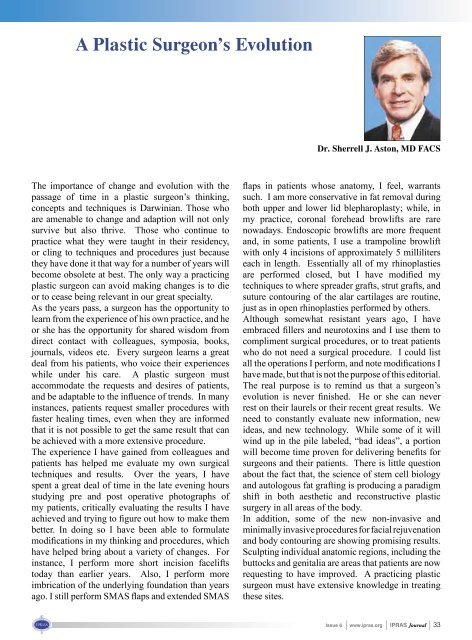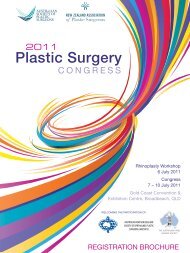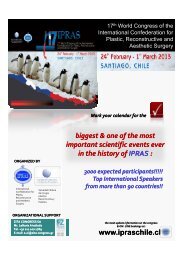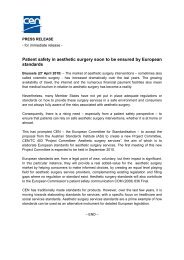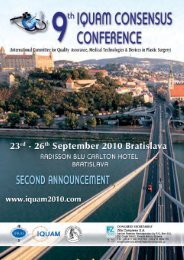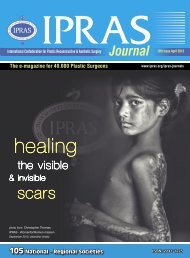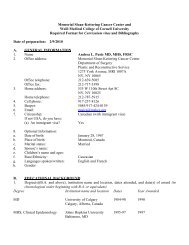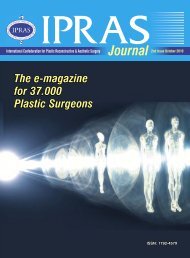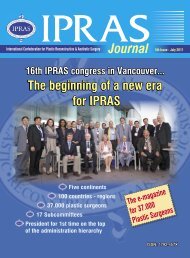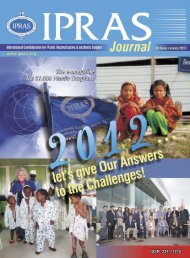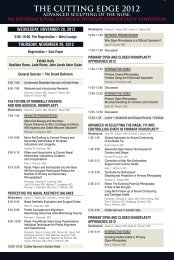Response to the “Lunch Time”Suture Suspension Liftingof Drs. Atiyeh, Costagliola, Dibo and HayekDr. Javier de Benito M.D.Congratulations to Drs. Atiyeh, Costagliola, Dibo and Hayekfor their prescient condemnation of the so-called “Lunch timeface lift”. Theirs has been the experience of many others, aswell as our own, but it has also prompted me to respond withour thoughts about the topic, as well as a few words regardingthe continuing evolution of a satisfactory way to accomplishwhat has eluded us, as described by those authors.In the world of medicine, Plastic Surgery is the specialtythat is evolving the most, along with the changes that aretaking place in society over time.Accordingly, the modern philosophy of life - possibly drivenby new technologies, such as the Internet, the mobile phonesand so forth, in which everything should be achieved in theshortest possible time - has influenced the developmentof procedures and techniques, which can adapt to thesechanging patients’ needs.The most recent of these trends has been the demand forfacial rejuvenation with minimal recovery time, in order toprotect one’s professional and social lives. The challengingeconomic times we are facing require everyone to lookhis (or her) best, without withdrawing from the world forseveral weeks.These minimally and non-invasive techniques include the useof suspension sutures, which can tighten the skin of the facewith hardly any scar or undermining, unlike in a traditionalface lift. Initially, these threads enjoyed a huge success, asthey attracted a vast demand from patients. Unfortunately,the success was short lived, as the results often proved verydisappointing. The threads did tighten the skin momentarilybut the results did not last more than 6 to 9 months.Besides, as, in many cases, the threads extruded through theepidermis, they needed to be removed.However, a lot of important data was gathered throughthis experience. In the first place, the technique raisedexpectations among patients and medical doctors.It also demonstrated that a proper system was required, onewhich would not only tighten the skin but also the deeptissue and not carry the deficits attached to the barbs.Five years ago, sutures with knots and bio-absorbable conescame to the market. The Silhouette Sutures enable elevationof the malar fat pad and the jaw line, along with lifting andreducing the jowls.In addition, the passage of time offers the opportunity to usethe fibrotic tissue formed inside the cones and around theknots to retighten sutures in order to increase the longevityof the lift for many years.The sutures are made of polypropylene; the cones are hollowand made with an L-lactic acid and glycolide copolymer.Each of the six cones is located between two knots.They are the only suspension sutures that have been approvedby the Food and Drug Administration and obtained the CEmark.The sutures are placed in the subcutaneous tissue, abovethe SMAS and are anchored in the temporal area to themuscle and the deep temporal fascia by means of a smallpolypropylene mesh.Our experience is based on five years of using these suturesfor the midface, as published in the Annals of PlasticSurgery- ISSN 0148-7043/09/6205-0001, Volume 62,Number 5, Date: May 2009, Start page: 478, # of pages : 3- and in Aesthetic and Plastic Surgery Journal - ISSN: 0364-216X, Vol: 35, Issue: 2, Date: 2011-03-01, Start page: 248,# of pages: 6.To date these sutures have been used in over16,000 cases in fifty three countries and over 1,000 surgeonshave been trained. The simple concept of using absorbablecones instead of barbs has made the technique successfulWe performed a retightening in 27 % of the cases, more thantwo years after the initial procedure.This procedure can be carried out on its own in onehour, under local anesthesia or in adjunction with otherrejuvenation protocols such as an endoscopic brow lift, aneye lid correction or a neck lift.Also, the “Global Face Lift Pack” is the only non-invasiverejuvenation system that consists of applying the sutures,combining them with botulinum toxin in the area betweenthe eyes and the crow’s feet and, if required, to lift the edgeof the eyebrow, as well as remodeling with hyaluronic acidin patients who need greater volume in their facial tissue.This procedure is not indicated for patients with atrophicor very thin skin, neither for patients with abundant facialflaccidity who would require skin resection. The presenceof permanent fillers in the areas where the sutures are placedis also a contraindication.Post operatively, a soft food diet is recommended for threeto five days. During this period of time, it is also importantto avoid dynamic movements of the jaw and to sleep on theback. This will prevent the cones from moving away fromtheir anchoring position.Surgery is in a state of evolution. We feel the sutures withabsorbable cones will be a step forward in the armamentariumof Plastic Surgeons in pursuit of facial rejuvenation inspecific cases.Javier de Benito M.D.Director of Institute de Benito USPDexeus Barcelona32 <strong>IPRAS</strong> Journal www.ipras.org Issue 6
A Plastic Surgeon’s EvolutionDr. Sherrell J. Aston, MD FACSThe importance of change and evolution with thepassage of time in a plastic surgeon’s thinking,concepts and techniques is Darwinian. Those whoare amenable to change and adaption will not onlysurvive but also thrive. Those who continue topractice what they were taught in their residency,or cling to techniques and procedures just becausethey have done it that way for a number of years willbecome obsolete at best. The only way a practicingplastic surgeon can avoid making changes is to dieor to cease being relevant in our great specialty.As the years pass, a surgeon has the opportunity tolearn from the experience of his own practice, and heor she has the opportunity for shared wisdom fromdirect contact with colleagues, symposia, books,journals, videos etc. Every surgeon learns a greatdeal from his patients, who voice their experienceswhile under his care. A plastic surgeon mustaccommodate the requests and desires of patients,and be adaptable to the influence of trends. In manyinstances, patients request smaller procedures withfaster healing times, even when they are informedthat it is not possible to get the same result that canbe achieved with a more extensive procedure.The experience I have gained from colleagues andpatients has helped me evaluate my own surgicaltechniques and results. Over the years, I havespent a great deal of time in the late evening hoursstudying pre and post operative photographs ofmy patients, critically evaluating the results I haveachieved and trying to figure out how to make thembetter. In doing so I have been able to formulatemodifications in my thinking and procedures, whichhave helped bring about a variety of changes. Forinstance, I perform more short incision faceliftstoday than earlier years. Also, I perform moreimbrication of the underlying foundation than yearsago. I still perform SMAS flaps and extended SMASflaps in patients whose anatomy, I feel, warrantssuch. I am more conservative in fat removal duringboth upper and lower lid blepharoplasty; while, inmy practice, coronal forehead browlifts are rarenowadays. Endoscopic browlifts are more frequentand, in some patients, I use a trampoline browliftwith only 4 incisions of approximately 5 milliliterseach in length. Essentially all of my rhinoplastiesare performed closed, but I have modified mytechniques to where spreader grafts, strut grafts, andsuture contouring of the alar cartilages are routine,just as in open rhinoplasties performed by others.Although somewhat resistant years ago, I haveembraced fillers and neurotoxins and I use them tocompliment surgical procedures, or to treat patientswho do not need a surgical procedure. I could listall the operations I perform, and note modifications Ihave made, but that is not the purpose of this editorial.The real purpose is to remind us that a surgeon’sevolution is never finished. He or she can neverrest on their laurels or their recent great results. Weneed to constantly evaluate new information, newideas, and new technology. While some of it willwind up in the pile labeled, “bad ideas”, a portionwill become time proven for delivering benefits forsurgeons and their patients. There is little questionabout the fact that, the science of stem cell biologyand autologous fat grafting is producing a paradigmshift in both aesthetic and reconstructive plasticsurgery in all areas of the body.In addition, some of the new non-invasive andminimally invasive procedures for facial rejuvenationand body contouring are showing promising results.Sculpting individual anatomic regions, including thebuttocks and genitalia are areas that patients are nowrequesting to have improved. A practicing plasticsurgeon must have extensive knowledge in treatingthese sites.Issue 6 www.ipras.org <strong>IPRAS</strong> Journal 33


